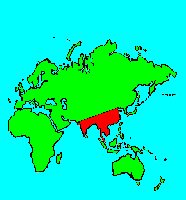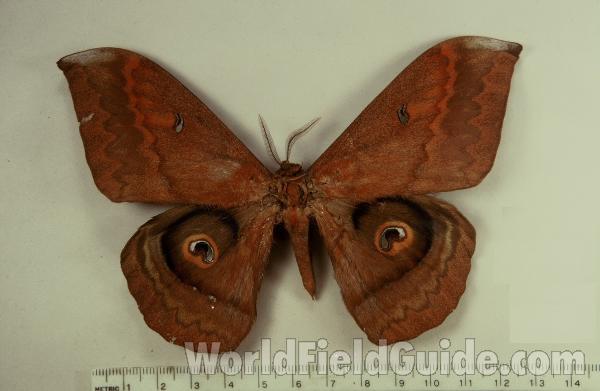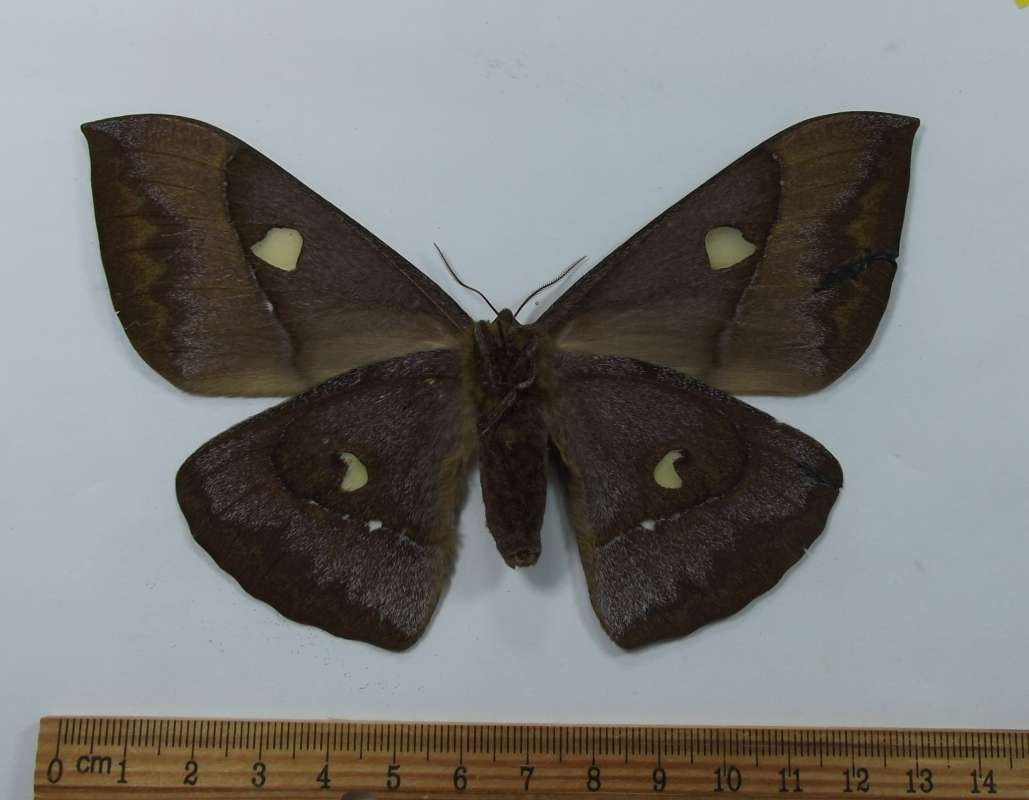SPECIES INFO
Salassa thespis is a large moth. The male mounted wingspread is about 13.5 cm.The unusual moths in the genus Salassa are found from India east through south east Asia into western China. There are some large and very large species in this genus in addition to some medium sized examples. Normally, the our editors work with scientific revisions and scientific summaries to ascertain the current and or correct taxonomy. For example, we have referred to Rothschild and Jordan for the New World Papilionidae and Le Moult for the Morpho revision and we also used more recent publications. We have attempted to make sense out of this Saturnid genus Salassa, but we clearly have only begun.
From the Moths of Thailand by Pinratana and Lampe published in 1990, we learn that Salassa lemaii and Salassa thespis were found in Thailand.
From D'Abrera Saturnidae Mundi published in 2012 we learn that the British Museum had specimens of: S. lola, S. mesosa, S. iris, S species(lemaii?), S. royi, S. thespis, and S. olivacea.
From the Web Site Saturnidae World, we see a list of about 28 species in the genus!
We have tentatively divided this genus into three portions and placed just a few species in each portion.
Medium sized species:
Salassa lola lola - Described by Westwood in 1847
Salassa royi - Described by Elwes in 1887
Salassa olivacea - Described by Oberthur in 1890
Large Species with pale (clear?) spotted median line in dorsal forewing
Salassa lemaii - Described by Le Moult in 1933
Salassa iris - Described by Jordan in 1910
Salassa thespis - Described by Leech in 1890
Large species with an red-orange zig zag medium line in dorsal forewing
Salassa megasticta -Described by Swinhoe in 1894
(D'Abrera places megasticta as a sub species of lola?)
Salassa mesosa - Described by Jordan in 1910
We have received specimens here identified by experts as follows, and we place them as subspecies of Salassa mesosa which might be erroneous.
Salassa mesosa tonkniana described by Le Moult in 1933
Salassa mesosa fansipana described by Brechlin in 1997.
(In Lampe Saturnidae of the World published in 2010, he pictures larvae of Salassa fansipana which he received from Mt. Fan-Si-Pan in North Vietnam at 1,525 meters)
Salassa genus belongs in its own subfamily.
Saturnid moths (family Saturnidae)are the giants of the moth world. They are usually characterized by their unique feather-like antennae. Males usually have larger antennae used to locate the females. Many species have transparent eye spots on their wings.
Typically, the males find the females upon emergence and copulate immediately. The United States government has frequently researched the sensing mechanism that permits the males to find the females in hopes of finding a military application.
Butterflies and Moths (Order Lepidoptera) are a group of insects with four large wings. They go through various life cycles including eggs, caterpillar (larvae), pupae, and adult. Most butterflies and moths feed as adults, but primarily do most of their growing in the larval or caterpillar stage. Also, most species are restricted to feeding as caterpillars upon a unique set of plants. In this pairing of insects to plants, there arises a unique plant population control system. When one plant species becomes too common, specific pests to that species also become more common and thus prevent the further spreading of that particular plant species.
Although most people think of the Lepidoptera as two different groups: butterflies and moths, technically, the concept is not valid.
Some families, such as Silk Moths (Saturnidae) and Hawk Moths (Sphingidae), are clearly moths. Other families, such as Swallowtail Butterflies (Papilionidae), are clearly butterflies, However, several families exhibit characteristics that appear to be neither moths nor butterflies. For example: the Castnia Moths of South America are frequently placed in the Skipper Family (Hesperidae). The Sunset Moths (Uranidae) have long narrow antennae and fly during the day.
The Saturnidae (Silk Moths) and Papilionidae (Swallowtails) are two Lepidoptera families that have been very carefully researched as to species and subspecies. The current thinking is that if the male genitalia are alike, then the two specimens belong to the same species. As an amateur, your editor disagrees with this premise. If the genitalia are different, then no doubt two species are involved. However, if the genitalia are alike, it only proves that the genitalia are alike.
Consider Papilio multicaudata which is found in southern Canada at higher altitudes. Papilio multicaudata is found south through the Rocky Mountains as far south as Mexico City, and recently as far south as Guatemala. With different food plants, different soil types, different climates, and different seasonal patterns, it is hard to believe that this complex is all one species.
Consider capturing 100 living individuals at any life stage in Guatemala and then carrying them north to southern Canada. Would these individuals survive through several generations. If they would not survive, then this author would conclude that two different species are involved!
In the Saturnidae consider Eacles imperialis subspecies pini. This life form feeds on pines. Is not this sufficient to justify a full species status?
Note: Numerous museums and biologists have loaned specimens to be photographed for this project.
Insects (Class Insecta) are the most successful animals on Earth if success is measured by the number of species or the total number of living organisms. This class contains more than a million species, of which North America has approximately 100,000. (Recent estimates place the number of worldwide species at four to six million.)
Insects have an exoskeleton. The body is divided into three parts. The foremost part, the head, usually bears two antennae. The middle part, the thorax, has six legs and usually four wings. The last part, the abdomen, is used for breathing and reproduction.
Although different taxonomists divide the insects differently, about thirty-five different orders are included in most of the systems.
The following abbreviated list identifies some common orders of the many different orders of insects discussed herein:
Odonata: - Dragon and Damsel Flies
Orthoptera: - Grasshoppers and Mantids
Homoptera: - Cicadas and Misc. Hoppers
Diptera: - Flies and Mosquitoes
Hymenoptera: - Ants, Wasps, and Bees
Lepidoptera: - Butterflies and Moths
Coleoptera: - Beetles
Jointed Legged Animals (Phylum Arthropoda) make up the largest phylum. There are probably more than one million different species of arthropods known to science. It is also the most successful animal phylum in terms of the total number of living organisms.
Butterflies, beetles, grasshoppers, various insects, spiders, and crabs are well-known arthropods.
The phylum is usually broken into the following five main classes:
Arachnida: - Spiders and Scorpions
Crustacea: - Crabs and Crayfish
Chilopoda: - Centipedes
Diplopoda: - Millipedes
Insecta: - Insects
There are several other "rare" classes in the arthropods that should be mentioned. A more formal list is as follows:
Sub Phylum Chelicerata
C. Arachnida: - Spiders and scorpions
C. Pycnogonida: - Sea spiders (500 species)
C. Merostomata: - Mostly fossil species
Sub Phylum Mandibulata
C. Crustacea: - Crabs and crayfish
Myriapod Group
C. Chilopoda: - Centipedes
C. Diplopoda: - Millipedes
C. Pauropoda: - Tiny millipede-like
C. Symphyla: - Garden centipedes
Insect Group
C. Insecta: - Insects
The above list does not include some extinct classes of Arthropods such as the Trilobites.
Animal Kingdom contains numerous organisms that feed on other animals or plants. Included in the animal kingdom are the lower marine invertebrates such as sponges and corals, the jointed legged animals such as insects and spiders, and the backboned animals such as fish, amphibians, reptiles, birds, and mammals.




